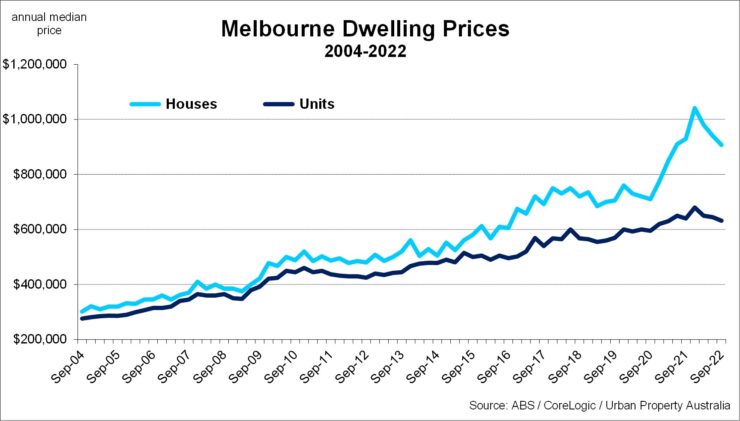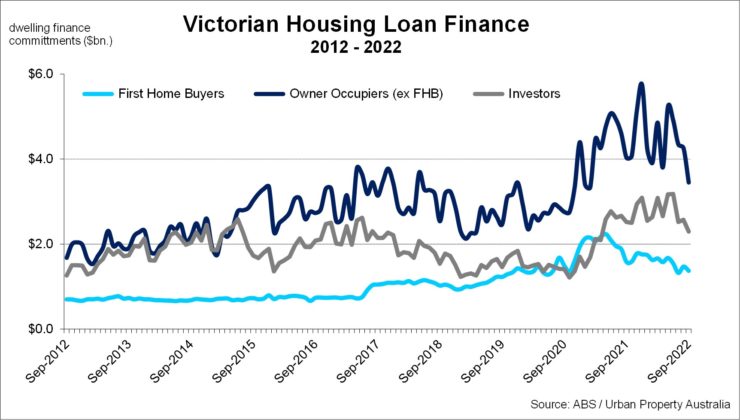Q3 2022 – Melbourne Residential Market
November 7th 2022 | , Urban Property Australia
- For a third consecutive quarter, both Melbourne’s median house and unit prices have declined, impacted by the rapid rise in interest rates, which have increased at the fastest rate since 1994;
- Vacancy rates have trended down across all regions over the year, with Melbourne’s metropolitan residential vacancy rate having halved since the peak of the pandemic;
- With vacancy rates falling back to the 10-year average, rents have increased across all regions with apartments outperforming houses over the year.
Residential Market Summary
For a third consecutive quarter, both Melbourne’s median house and unit prices have declined, impacted by the rapid rise in interest rates. Melbourne’s median house prices are now 13% lower than the peak with unit prices 7% lower than their peak. With Victoria’s population once again, current total annual Victorian housing finance commitments sit 54% above the 10-year average. The elevated housing finance levels have been underpinned by owner occupiers, however, investor activity continues to gather momentum, accounting for a third of all housing loans.
Prices
For a third consecutive quarter, both Melbourne’s median house and unit prices have declined, impacted by the rapid rise in interest rates, which have increased at the fastest rate since 1994. With Melbourne’s median house prices now falling to $907,000, values are now 13% lower than the peak of December 2021. Similar to the detached housing sector, Melbourne median unit prices have eased in 2022, decreasing to $632,000, 7% lower than its peak at the end of 2021. Both Melbourne median house prices and unit values have now fallen to their lowest levels since March 2021. Looking ahead, with further rises in the interest rate coupled with elevated inflation levels, purchasers borrowing capacity has been adversely impacted which will constrain growth of values.

Supply
According to the ABS, there are currently 72,000 dwellings under construction across Victoria, close to all-time high levels. The number of dwellings currently under construction is 18% above the 10-year average having increased by 10% over the year. The number of both houses and units under construction across Victoria are above their respective 10-year averages. Having fallen to six-year lows, the number of units under development continues to recover, having been adversely impacted by the closure of Australia’s international borders and declining population growth. Over the past year, Victoria’s population grew by 41,500 having previously declined in 2020 as residents moved interstate and offshore. In the 12 months to September 2022, a total of 62,000 dwellings were approved in Victoria, slightly below the 10-year average. Reflecting the slowdown of the development of unit developments, approvals for units now account for 39% of all new dwellings approved, compared to 52% as at October 2015.
Demand
With Victoria’s population once again growing having contracted over 2020 and 2021, current total annual Victorian housing finance commitments sit 54% above the 10-year average in September 2022 with $106 billion financed. The elevated housing finance levels have been underpinned by owner occupiers with current levels sitting 20% above the 10-year average. Although first home buyers remain active in the market with current levels at 28% above their 10-year average, levels appear to have peaked with levels decreasing 17% over the year to September 2022. Similar to the owner occupier sector, investor finance has also softened over the September quarter, impacted by higher borrowing costs. While investor financing volumes have eased in recent month, investors now account for 32% of total housing finance commitments in Victoria, compared to their share 25% two years ago. Looking ahead, with vacancies falling and rents continuing to recover, Urban Property Australia expects that investors will continue to grow their share of housing finance.

Vacancy
According to the REIV, as at September 2022, the vacancy rate for Melbourne residential property fell to 3.2%, down from its peak of 6.5% of March 2021, however remains above its 10-year average of 3.1%. While vacancy rates have trended down since peaking in mid-2021, only the Outer Melbourne region, and interestingly the Inner (0-4km) precinct records vacancy below their respective 10-year average. Over the year to September 2022, the residential vacancy rate declined to 3.2% in the Inner (0-4km) precinct, down from 5.7%. The vacancy rate of the Outer precinct has now fallen to 1.6%, with all regions recording declines in vacancy over the year. Looking ahead, Urban Property Australia projects that the vacancy rate for the metropolitan Melbourne area will fall below the long-term average in 2023, with construction activity declines coupled with population growth of Melbourne’s continuing to gather momentum.
Rents
Mirroring the improving vacancy trends, according to the REIV, metropolitan residential rents across the precincts increased over the past year. Over the year to September 2022, the weekly median rent for houses in metropolitan Melbourne increased to $500 per week, up from $495 per week a year earlier. Across Melbourne, rents for houses located in the Outer region increased by 4.7%, with rents in the Middle region increasing by 1.0% and the rents in the Inner precinct remaining steady. Interestingly, rents for Melbourne units increased by 4.8% over the year with unit rents rising across the precincts. Looking forward, Urban Property expects that residential rents will steadily increase as prospective buyers will have a lower borrowing capacity impacted by higher interest rates.
Copyright © 2022 by Urban Property Australia All rights reserved. No part of this publication may be reproduced in any form, by microfilm, xerography, electronically or otherwise, or incorporated into any information retrieval system, without the written permission of the copyright owner.



